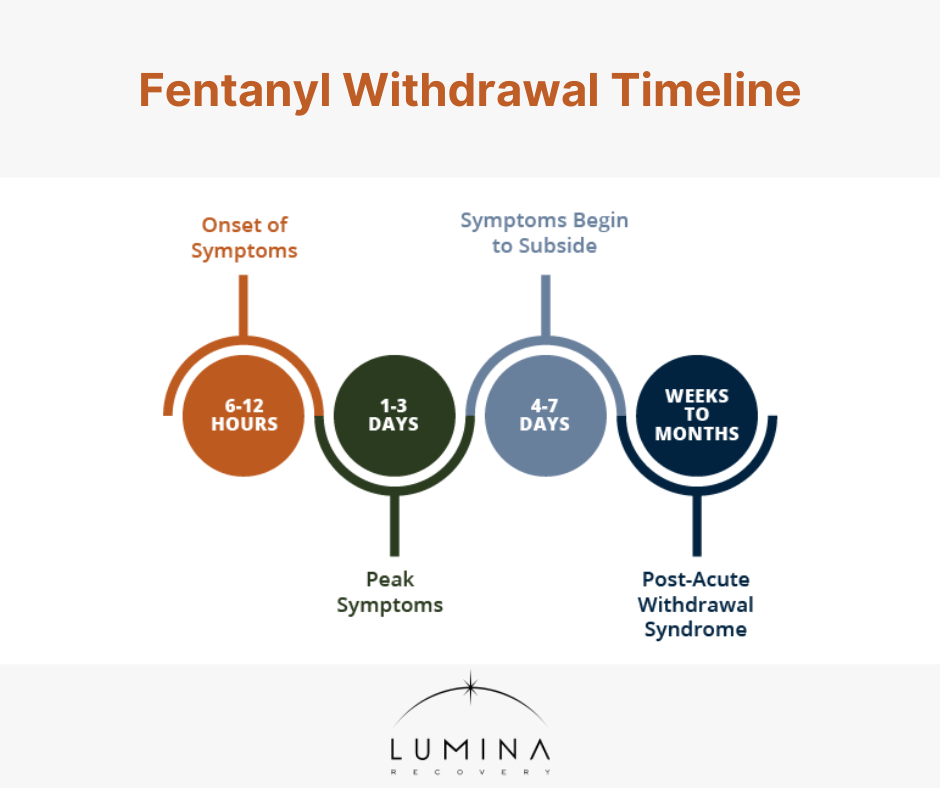Fentanyl is a synthetic opioid that is 50 to 100 times more potent than morphine. It is often prescribed for severe pain management but has gained notoriety due to its misuse and highly addictive properties.1
Understanding fentanyl withdrawal is a critical step toward recovery, as navigating the process safely and effectively can improve the chances of long-term sobriety.
What Is Fentanyl?
Fentanyl was first developed as a pain-relieving medication. In medical settings, it is used for post-surgical pain or chronic pain in cancer patients.
However, illicit fentanyl—often mixed with other drugs—has fueled the opioid and fentanyl crisis in America. Its potency makes it highly addictive, even after short-term use, increasing the risk of overdose and dependency. Many users are unaware of the fentanyl content in substances they consume, contributing to a rapid rise in substance abuse rates and accidental overdoses.
While prescription fentanyl is carefully regulated, street versions are frequently mixed with other opioids, creating dangerous combinations that further increase dependency. Recognizing fentanyl addiction early can help prevent severe complications and support a structured recovery plan.
Why Does Fentanyl Withdrawal Occur?
Withdrawal occurs when the body adapts to the constant presence of fentanyl. Over time, users develop a tolerance, requiring higher doses to achieve the same effects. This dependence results in physical and psychological symptoms when fentanyl use stops.
Fentanyl binds to opioid receptors in the brain, altering pain perception and triggering dopamine release. When use is discontinued, the brain struggles to regain balance, leading to withdrawal symptoms. The severity of these symptoms often discourages individuals from quitting without medical assistance, making professional support a key component of successful recovery.
Fentanyl Withdrawal Symptoms
Symptoms of fentanyl withdrawal can manifest physically and psychologically, which can be uncomfortable and dangerous. The severity and duration of opioid withdrawal symptoms often depend on the duration of use, the amount used, and individual health factors:1
- Muscle and Joint Pains: These can be severe and feel similar to a bad flu.
- Gastrointestinal Distress: This includes nausea, vomiting, diarrhea, and stomach cramps, which are common and particularly discomforting.
- Cold Flashes With Goosebumps: These symptoms can be accompanied by uncontrollable shivering.
- Sweating: Excessive sweating is typical, regardless of the temperature or physical activity levels.
- Uncontrollable Leg Movements: Known as “restless legs syndrome” in some contexts, this symptom involves involuntary leg twitches and jerks that can make it difficult to rest or sleep during withdrawal.
- Insomnia and Sleep Disturbances: Difficulty falling asleep, staying asleep, or experiencing restful sleep is common.
- Cravings: Intense cravings for fentanyl are one of the most challenging aspects of withdrawal, often leading to relapse if not properly managed.
Fentanyl Withdrawal Timeline
The withdrawal from fentanyl is a multi-stage process, each stage characterized by various symptoms. Understanding the fentanyl withdrawal symptoms timeline is essential for anyone facing recovery from fentanyl dependency. The timeline can vary but typically follows this pattern:2
Stage 1: Onset of Symptoms (6-12 hours)
Symptoms start mild and gradually increase in severity. These include muscle aches, anxiety, and a strong craving to use the drug.
Stage 2: Peak Symptoms (1-3 days)
This is when symptoms are at their worst. Physical symptoms such as nausea, vomiting, diarrhea, and severe muscle aches are common. Psychological symptoms such as anxiety, depression, and intense cravings also peak during this time.
Stage 3: Symptoms Begin to Subside (4-7 days)
Physical symptoms start to lessen in intensity, but psychological symptoms like depression and cravings may persist. This is a critical period where support is essential to reduce the risk of relapse.
Post-Acute Withdrawal Syndrome (Weeks to Months)
Some symptoms, particularly psychological ones like mood swings, anxiety, and ongoing executive dysfunction can persist for weeks or months after the initial withdrawal period.
Post-acute withdrawal syndrome (PAWS) can make long-term sobriety challenging and requires continued support and possibly ongoing therapy.3
Factors That Affect Withdrawal
Several factors influence the severity and duration of withdrawal:
- Dosage and Duration: Higher doses and longer use result in more intense withdrawal.
- Individual Health: Age, metabolism, and overall health impact recovery.
- Co-occurring Conditions: Mental health issues or other substance use disorders can complicate withdrawal.
- Support System: Individuals with family or professional support often experience better outcomes.
- Environment: A stress-free, supportive setting can promote recovery.
Coping With Withdrawal Symptoms
Managing withdrawal symptoms effectively is a vital part of the recovery process. Developing both short-term and long-term coping tools can provide the support needed to navigate this challenging time successfully.
Short-Term Coping Strategies
- Stay hydrated and eat nutritious foods to maintain energy.
- Get plenty of rest and engage in light exercise to boost endorphins.
- Practice relaxation techniques like meditation and deep breathing to reduce anxiety.
Long-Term Coping Tools
- Attend therapy and support group meetings to stay accountable.
- Develop relapse prevention strategies, such as identifying triggers and learning new habits.
- Build healthy routines, including regular exercise and stress management techniques, to support emotional well-being.
Fentanyl Detox and Treatment Options
Fentanyl detox is a critical step in addiction treatment to this powerful opioid. Because fentanyl is highly addictive and withdrawal symptoms can be severe, medically supervised detox programs are often the safest and most effective approach.
Medical Detox
Supervised detox programs offer a safe environment where symptoms are managed with medications and professional care. Monitoring ensures that patients stay hydrated, receive proper nutrition, and avoid dangerous complications.
Medication-Assisted Treatment (MAT)
Medications such as naltrexone, methadone, and buprenorphine are used to reduce cravings and manage withdrawal symptoms. These treatments support long-term recovery by stabilizing brain chemistry and easing physical dependence.
Therapies and Counseling
Many outpatient and inpatient rehabs use cognitive behavioral therapy (CBT) and group therapy to address the psychological aspects of addiction, which promote long-term recovery. Individual therapy sessions can help uncover underlying triggers and build coping strategies.
Frequently Asked Questions (FAQs)
1. How long does it take for fentanyl to leave your system?
Fentanyl typically leaves the system within 24–72 hours, but withdrawal symptoms can last longer.
2. How long do fentanyl withdrawals last?
Acute withdrawal symptoms generally last 1–2 weeks, while psychological symptoms can persist for months.
3. What is one of the first signs of withdrawal?
Anxiety and restlessness often appear first, signaling the onset of withdrawal.
Find Long-Term Recovery With Lumina Recovery
Fentanyl withdrawal can be overwhelming, but understanding the symptoms and fentanyl withdrawal timeline is the first step to a healthier life. With the right support, recovery is possible.
Lumina Recovery’s treatment centers offer medical detox to help manage fentanyl withdrawal symptoms safely and medication-assisted treatment (MAT) to reduce cravings and promote long-term success.
If you or a loved one is struggling with fentanyl addiction or an opioid use disorder, contact Lumina Recovery today to learn about our customized treatment plans.
Sources:




